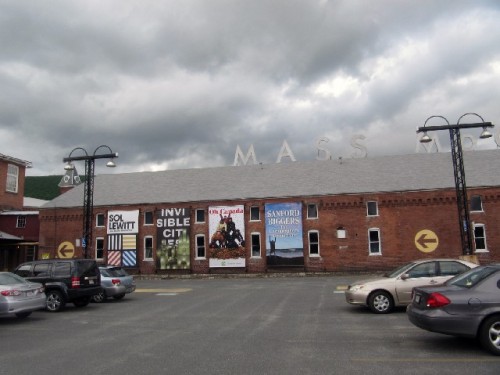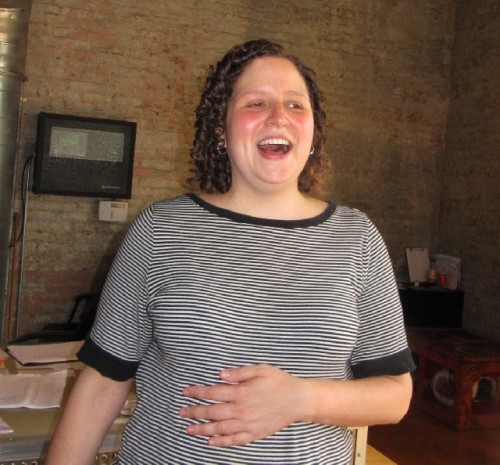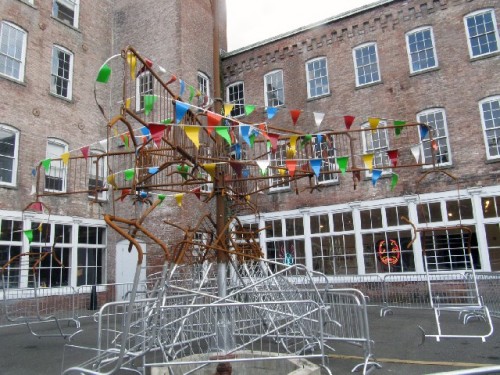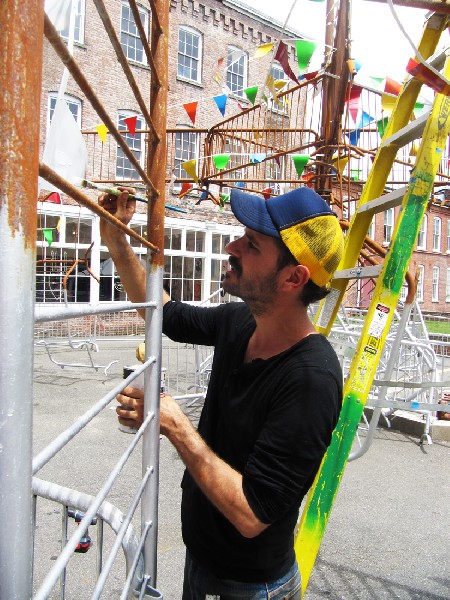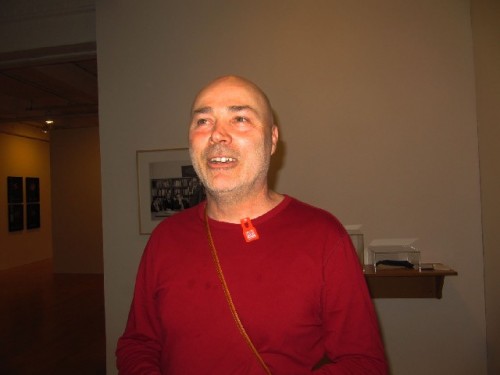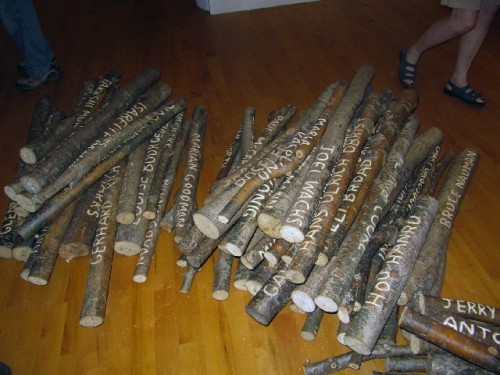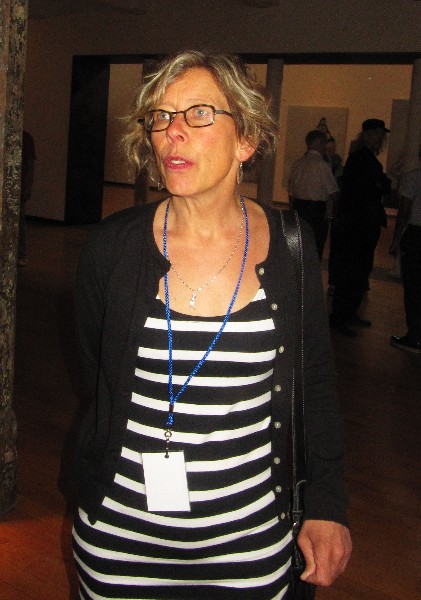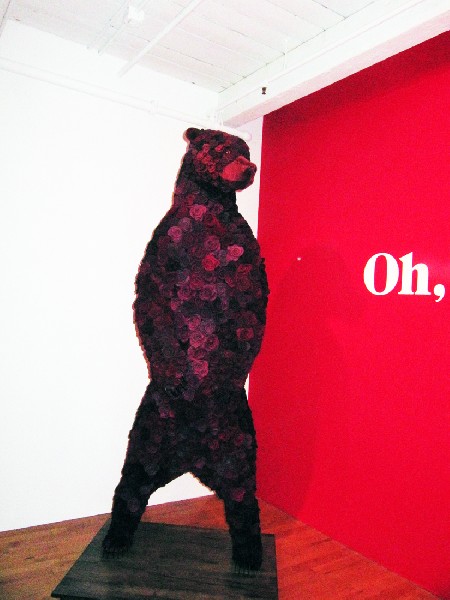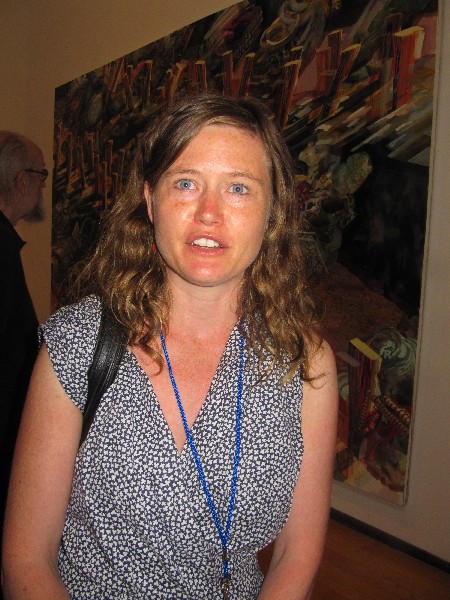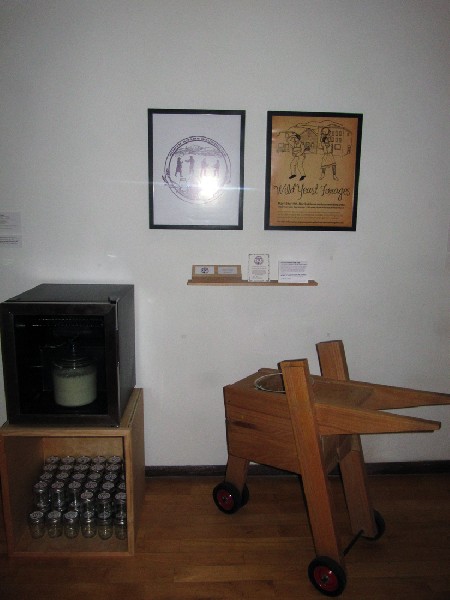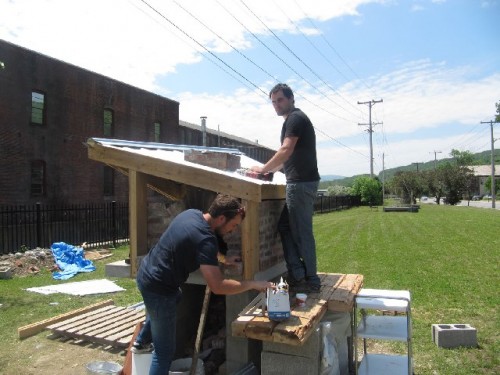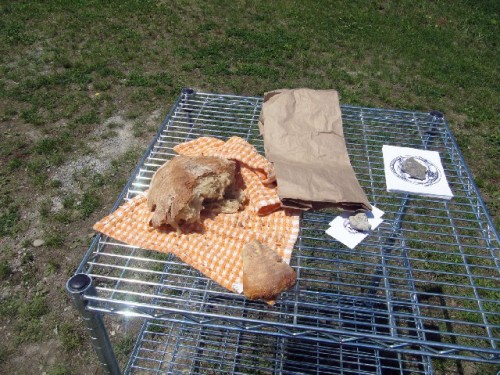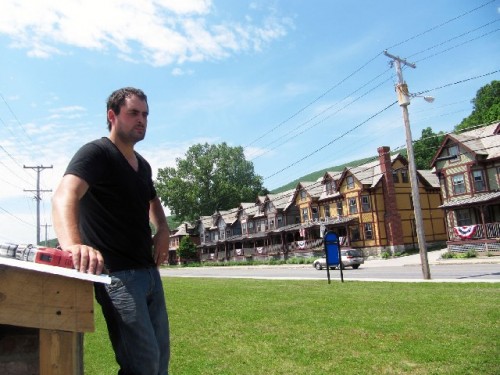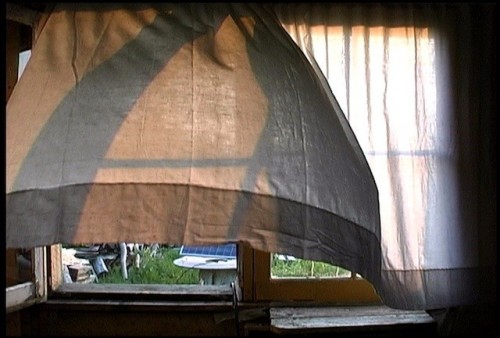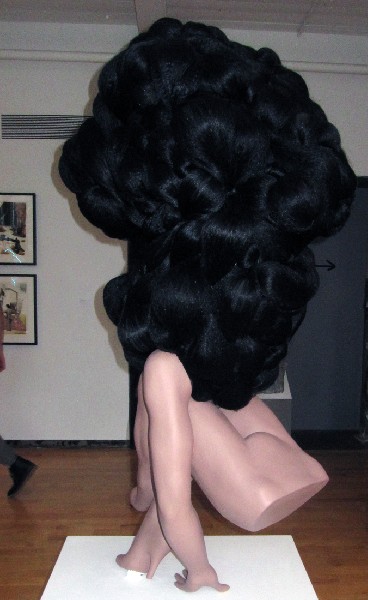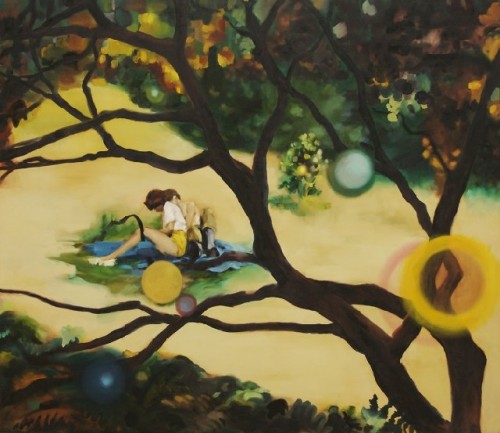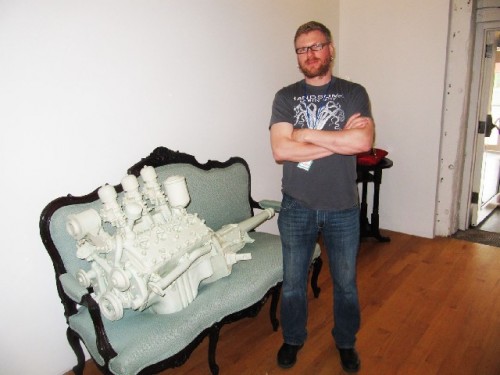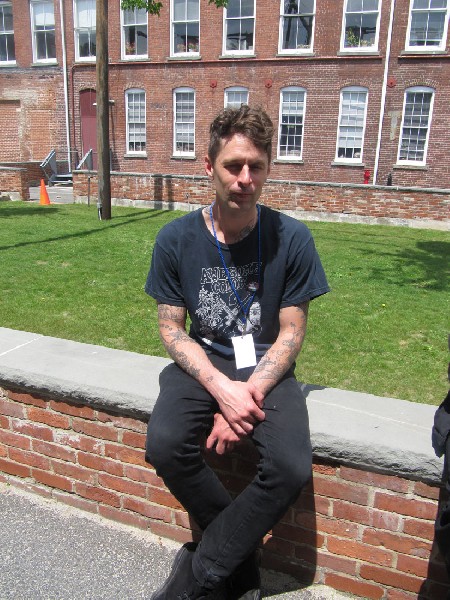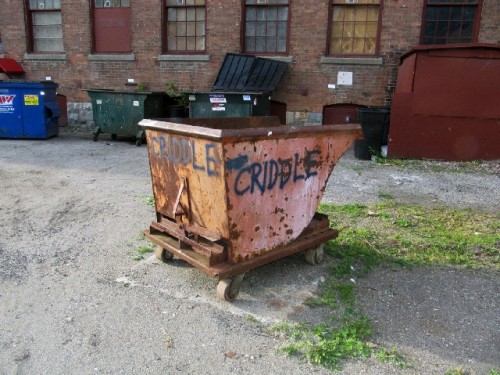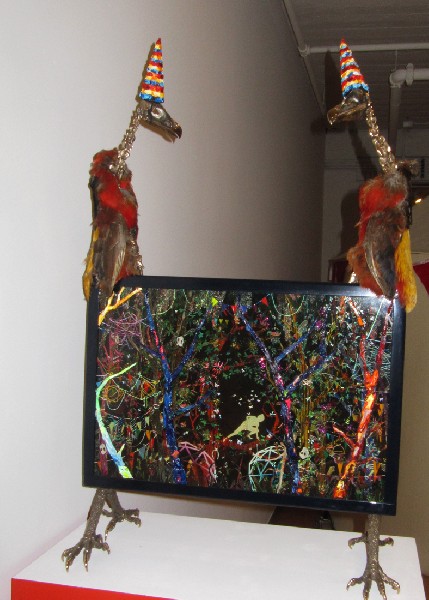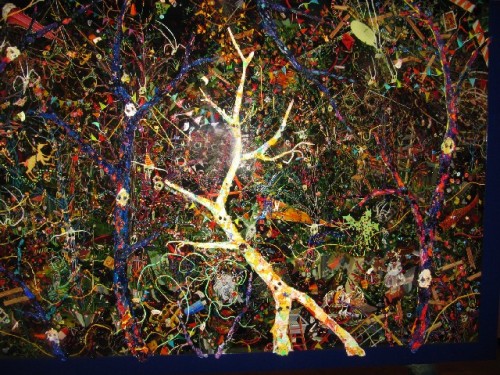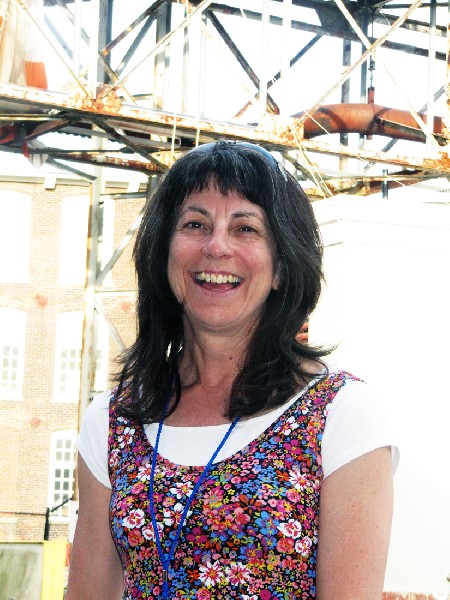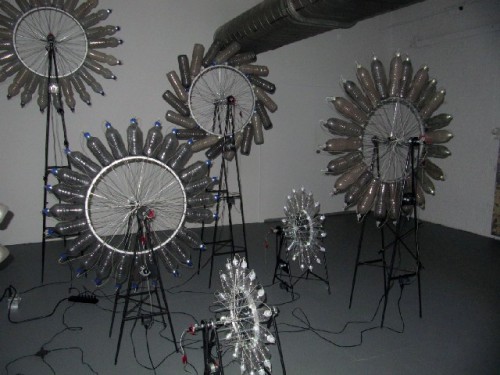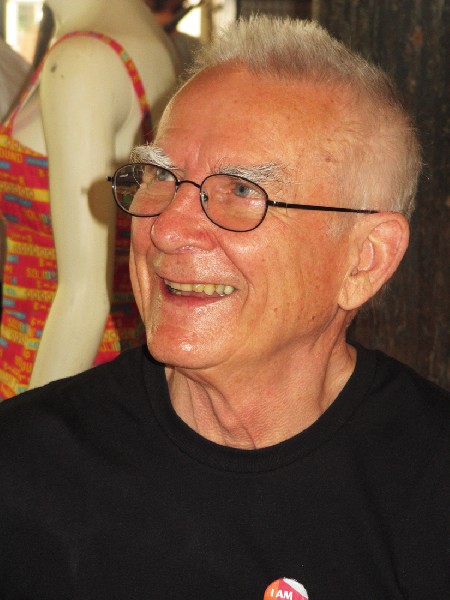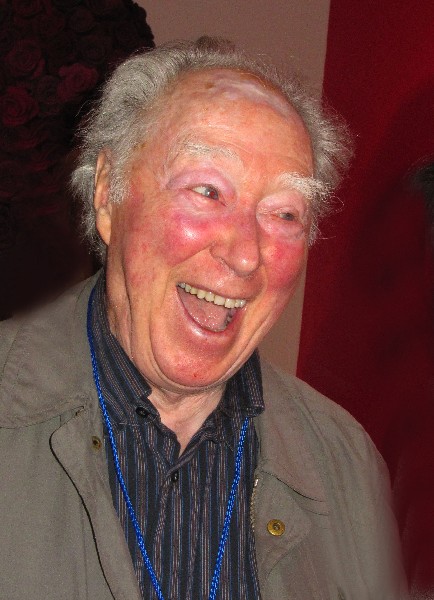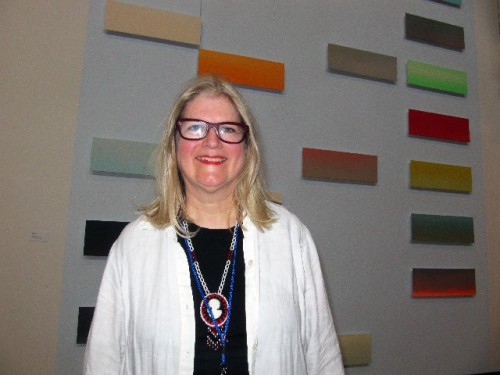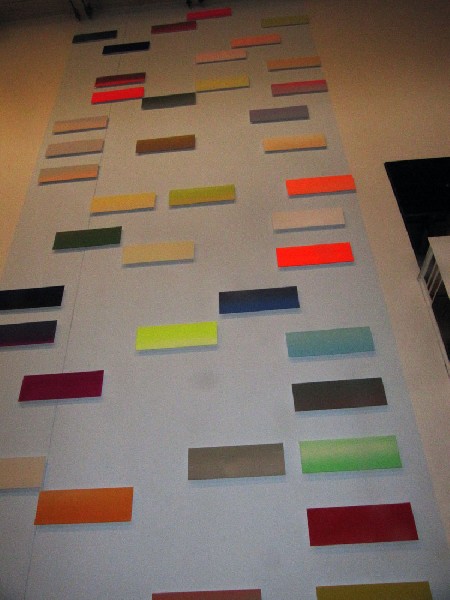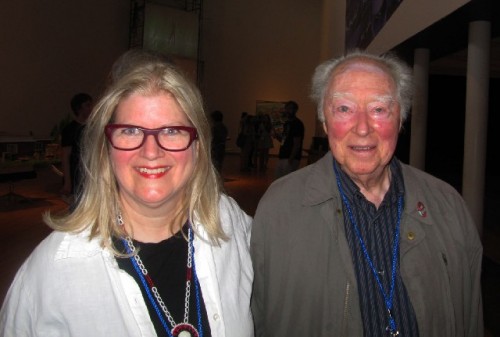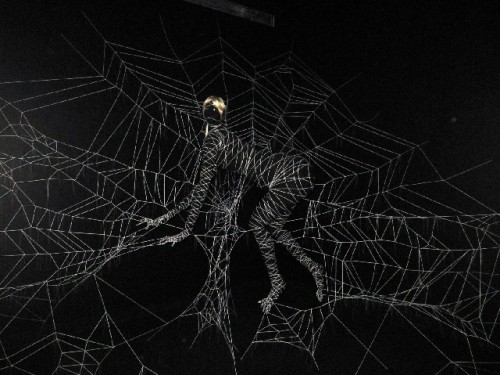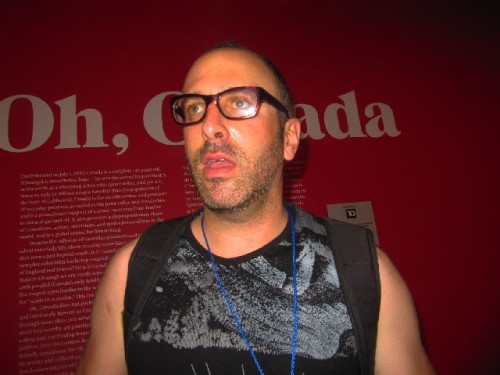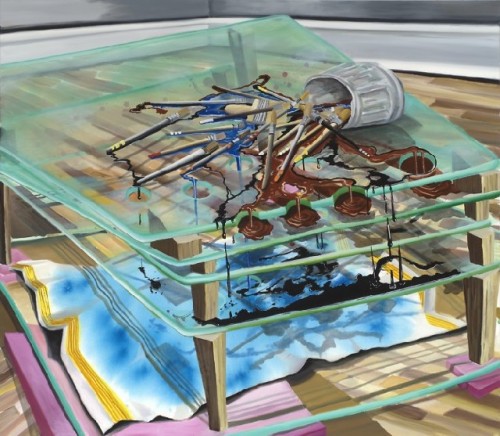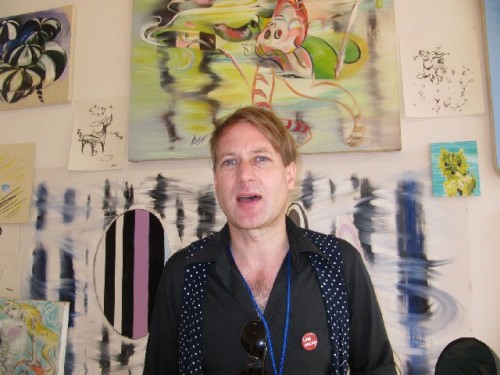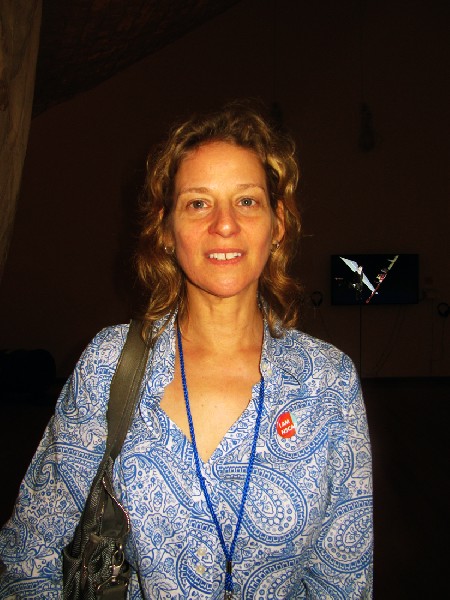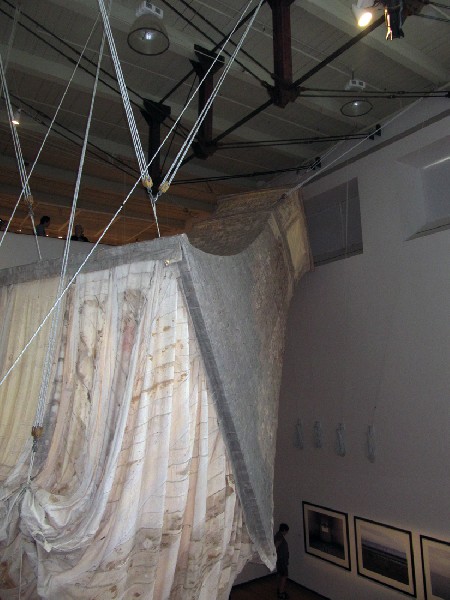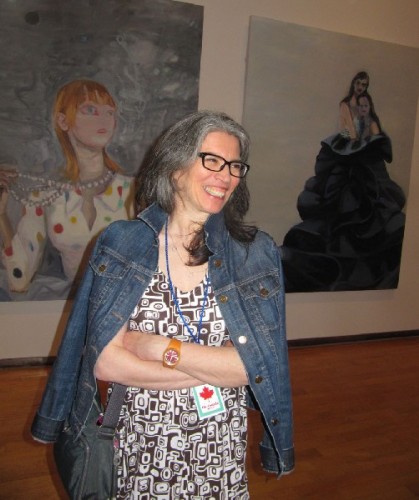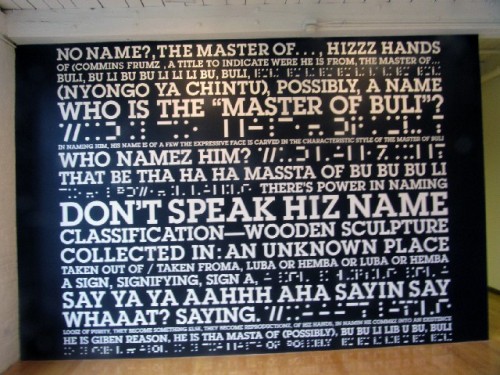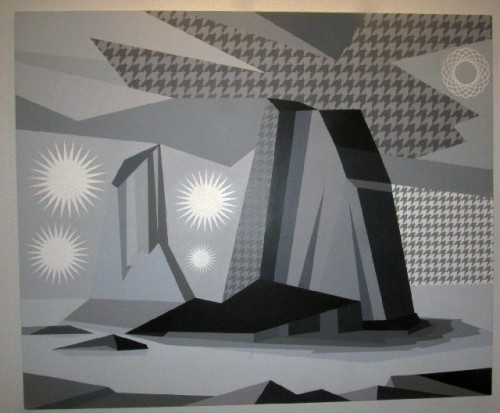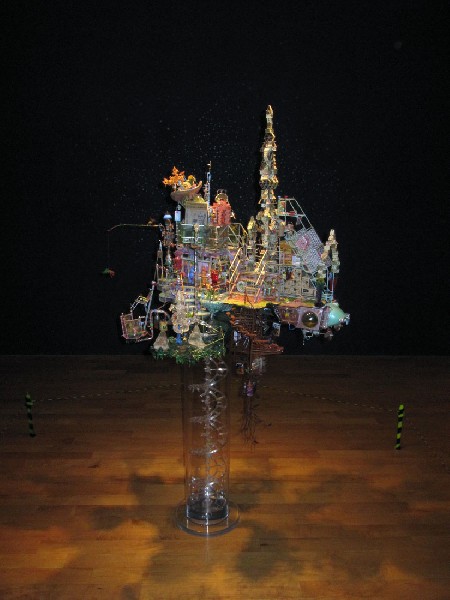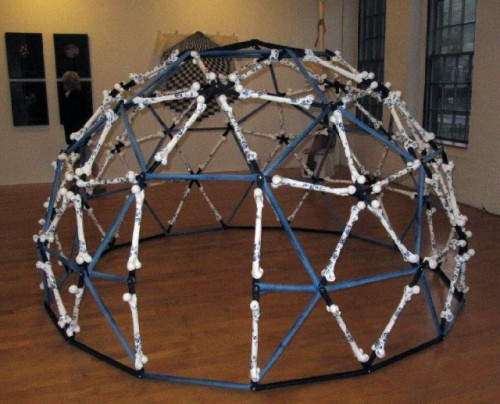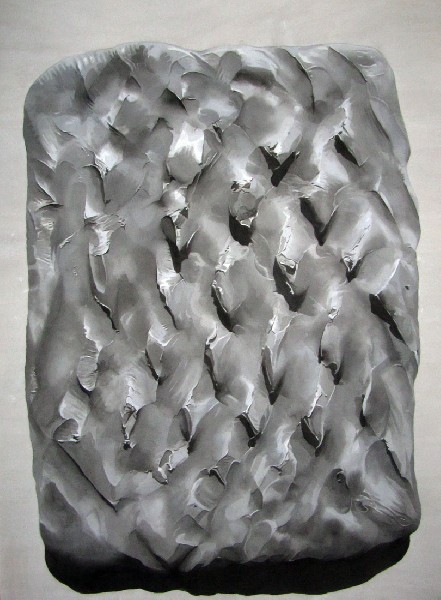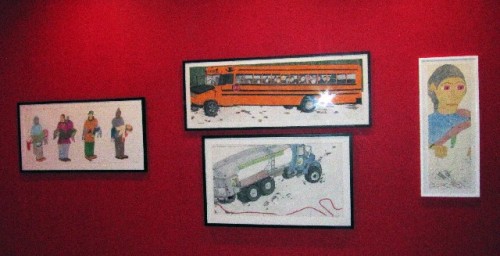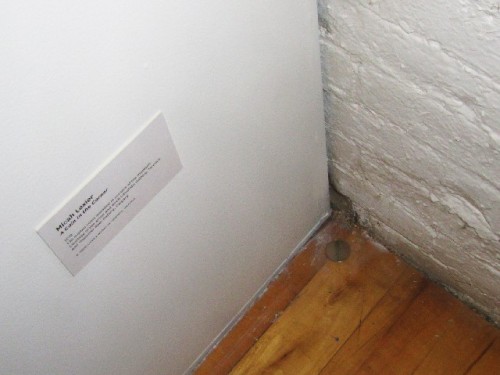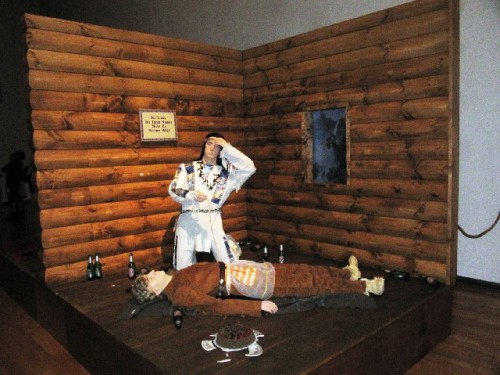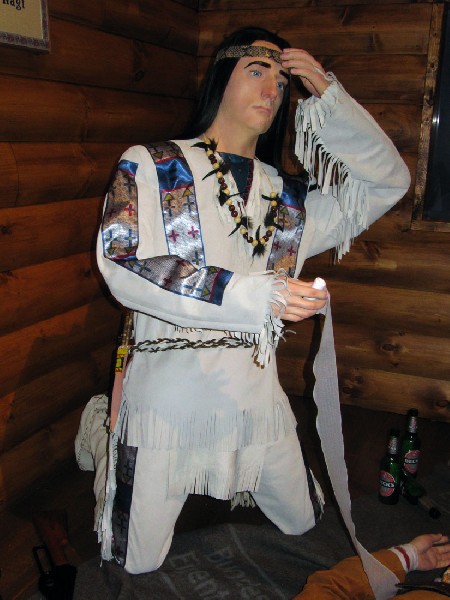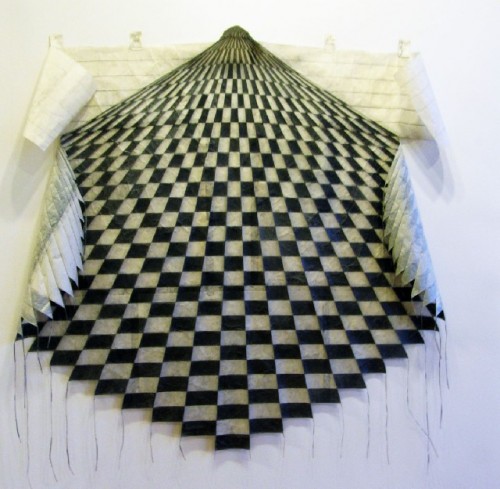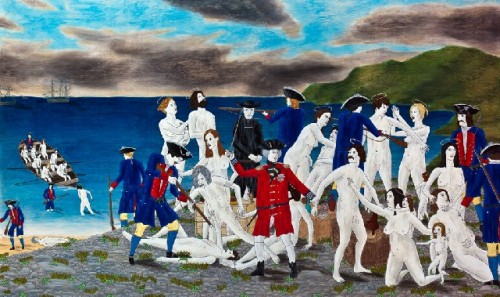OMG Canada at Mass MoCA
Daunting Survey of Canadian Art
By: Charles Giuliano - May 28, 2012
The sprawling, dense, complex, exhilarating, confounding Oh Canada, which opened this past weekend at Mass MoCA where it will remain on view for the next ten months, is the visual equivalent of a polyglot menagerie evoking Noah’s Arc.
No, it has not rained in the Berkshires for forty days and forty nights. But curator Denise Markonish has so jammed the museum with every possible species of creativity, garnered through some 400 studio visits covering the length and breadth of Canada, that there is the need to release a dove to find dry land and return with an olive branch of productive critical discourse.
Her accessible, enjoyable, well written and daunting 38 page essay for the catalogue, which will not be available until July, is crammed with a synthesis of an odyssey with thorough archival and documentary research. It is fair to state that she is on the short list of notable, non Canadian scholars/ curators of contemporary Canadian art.
The very nature of such an enormous project, to survey a moment in time of a nation’s visual product, is problematic. But her essay cleverly raises and addresses every possible critical issue from the absurdity of such an undertaking, the point of view of a single outsider with an unidentified cluster of shadow advisors, to critiques of the glut of global biennials.
Markonish is a well schooled and articulate curator and art historian who seemingly has all the answers. She has created a smart and clever exhibition, beautifully installed by Richard Criddle a wizard in the field, that will surely enlighten and delight visitors to the museum.
How it will sit with experts in the field, Canadian critics and curators, and the often harsh mainstream art media, remains to be seen. Until now, coverage has been comprised mostly of puff pieces by regional media and cheer leading from a handful of Canadian news organizations.
We spent the weekend absorbing the exhibition mostly through the lens of celebration, many of the artists attended, and social networking.
On Saturday morning there was an opportunity for the media (sparsely attended) to meet with artists who were asked to be available next to their work. This was an invaluable experience providing insights to the practice. During the hour and a half so allotted we tried to meet with as many artists as possible, photographing and recording their comments to be transcribed and posted at a later time.
There were artists we sought out who were not present, who departed for lunch, or to rest for the evening opening. A number of the younger artists we talked with were dealing with hangovers from raucous partying the night before.
Given the vastness and significance of this first, major American museum survey of Canadian art what follow are preliminary impressions. While Markonish’s critical essay is provocative it was frustrating not to have the entire catalogue. There was no possibility of following her references to the 400 or so works that will be reproduced. There is no index of images on the MoCA website. The press kit did not include pro forma brief bios of the participating artists.
Again, with an emphasis on the historical importance of the occasion, and the unique, once in a lifetime, gathering and snap shot of pan-Canadian artists, it is disappointing that there was no educational component during the opening weekend.
A number of the artists we spoke with had been in extended residence to install the work and will return at the end of the show to pack up. There is considerable expense in having so many artists travel. It was a missed opportunity not to have artist talks, panel discussions, or a colloquium on Canadian art.
This neglect of public education is all the more remarkable given MoCA’s unique ties with its intellectual, curatorial and art historical neighbors Williams College and The Clark Art Institute. Both those institutions are noted for hosting seminars and colloquia related to their exhibition projects. As was the case when the long term Sol LeWitt building first opened at MoCA.
This ambitious project was about identifying, selecting, and inviting a cross section of the Canadian arts community. It would have been appropriate to connect the visiting artists with the unique and growing Berkshire arts community. That cross pollination could have been stunning.
Of course what counts, bottom line, is the work itself. What is great about living within walking distance of a major museum is an invitation to absorb such a complex exhibition over an expanse of time through research, critical thinking, reviews, and peer dialogues.
For most visitors to Oh Canada this is an introduction to the creativity of our neighbor, trading partner, and closest ally. On a personal level it reinforces decades of visiting Canada, not as often as one would like, looking at and thinking about its visual culture.
Reading through Markonish’s text there were many points of familiarity and connection as well as new information and tangents for further research. So there was a dynamic layering adding to prior information.
Given that there has never been an American museum Canadian project on this scale one might have hoped to find a few more monuments, or landmarks to help navigate what is, for the most part to the international art world, terra incognita. On the cultural map of North America this is where is reads hic transit dracones. Marco Polo where are you when we need you?
Those signifiers to some extent do exist in the project and help to create a baseline of gravitas however thin in density. In criss-crossing Canada, including by snow mobile, Markonish seemed to find her visit to Halifax particularly productive. There she tapped into the distinguished history of the Nova Scotia College of Art and Design (NSCAD). During the opening a number of faculty and former students wore identifying buttons.
Two of its most distinguished associates- the 86-year-old, world renowned, multi media artist, Michael Snow, and the school’s long term former director, Gary Neill Kennedy, (1967-1990) are included in the exhibition. I managed to interview Snow and will post that later. It was an amazing experience to encounter such a legendary artist. Kennedy was in the lobby signing copies of The Last Art College, Nova Scotia College of Art and Design, 1968-1978, 2012, MIT Press, 480 pages.
As a pioneer of film and video in his work the single frame video by Snow conflates smoothly with the pulse of contemporary art. The poetic piece is a fixed view of a curtain wafted by a breeze in the artist's summer cottage. Now and then it flutters and slaps with a flattening thud against the screen. We catch glimpses of the yard and a solar panel.
The large, horizontal grid of 72 collaged photos of a military plane, by Kennedy, hovers above us in the main gallerty. It evokes the notion of surveillance of an enemy below, a potential target for bombing. Obliquely it comments on Canadian involvement in wars initiated during the Bush era.
Another significant resource for Oh Canada is Montreal’s Concordia University with nearly 25 per cent of the artists and curators featured in the exhibition. The list includes the artists Nicolas Baier, Dean Baldwin, Étienne Zack, Michel De Broin, Mary-Anne McTrowe (of the Cedar Tavern Singers AKA Les Phonoréalistes), Eryn Foster, Myfanwy MacLeod, Clint Neufeld, and Charles Stankievech. As well as contributing curators David Liss and Lance Blomgren.
Visitors asking the inevitable question of “what is Canadian about Canadian art?” will come away with few if any answers. More astute observers will find threads and points of confluence. Markonish and the MoCA installers have opted to present the works in a manner that is visibly palatable. There is no attempt at grouping by subtext or theme. Nor is there any clue to geographic sources. We see the whole and are discouraged from finding the sum of the parts.
The essay indicates that there are First Nations artists. But good luck in finding them. Some are obvious, for example the drawings of village life by Annie Pootoogook (Cape Dorset, Nunavut) or her relative Shuvanai Ashoona (Cape Dorset, Nunavut). One may ask whether this traditional, folk art figuration is appropriate for a cutting edge survey. On the other hand the artist Rebecca Belmore (Vancouver, British Columbia) represented here by Eagle Drum, 2012, looped video in oil drum, video by Frank Robideau, was included in the 2005 Venice Biennale.
A number of the artists, such as Snow, or Wanda Koop (Winnipeg, Manitoba) (represented here by Look Up, 2009, a vertical loose grid of horizontal more or less monochromatic paintings) exhibit internationally. Koop told me that she last showed in New York in the former government sponsored gallery 49Th Parallel.
Noam Gonick and Luis Jacob (Winnipeg, Manitoba and Toronto, Ontario) are showing a geodesic dome with erotic video projections and a live teenaged, male model Wildflowers of Manitoba, 2008. We caught up with Gonick while he was racing off to find the missing model. It is a wonderfully evocative piece about a boy in his teen cave surrounded by erotic projections including mustached men in tutus. “This is the eleventh iteration of the piece” he commented. “The most recent was the Berlin Film Festival.”
There is a lot of playful bait and switch going on it the exhibition. Some of the work is in your face, seemingly paradigmatic Canadian.
There is an over the top kitschy log cabin, two part diorama by Kent Monkman (Toronto, Ontario) Two Kindred Spirits, 2012. Prominently placed in the main gallery, like a strident adolescent it screams for our attention. There was a Paul McCarthy, déjà vu all over again, sense of yet another tasteless, gonzo prank. There is a German (Karl May?) and English schism of the diorama which conveys separate versions of a traditionally attired Indian hovering, lording over, triumphant over, the passed out/ possibly slain Lone Ranger or a trapper in buckskins.
Arguably, we have already given Monkman’s corny work more attention than it deserves. Is Amalie Atkins (Saskatoon, Saskatchewan) Three Minute Miracle: Tracking the Wolf, 2008, felt tent, mixed media, with video more deserving of our time and attention? Perhaps marginally so but I found the whole take, with its curved row of scaled felt boots, too, well, F.A.O. Schwarz. Remember them?
In the realm of branding and signifiers of Canadaissomo the most ambitious and challenging work was Kim Morgan’s (Halifax, Nova Scotia) Range Light, Borden-Carleton, PEI 2010, 2010, latex 60 ft. Good grief, the NSSAD faculty member has created a full scale, latex mold of a friggin' light house. At 60 ft. it’s too big to stand up even in Mass MoCA. It is hung more or less at an angle and pretty much impossible to comprehend from eye level. There is a better view of it from the second floor balcony that looks down on the exhibition space.
During the opening many visitors appeared to be shadow boxing with specters of the muse of Canadiana. Perhaps, in an interlude during the Friday night preview, they were smitten by the oh so cute, ditty by Cedar Tavern Singers ( Daniel Wong, and Mary-Anne McTrowe, Oh, MASS MoCA. I found it as light and ephemeral as helium. Apparently, the kids compose and perform catchy little tunes about the Canadian art world. The Cedar Tavern in the title references the watering hole near Washington Square Park in Manhattan. In my Holden Caulfield period, during college spring break, I wandered in for a beer anticipating getting drunk with deKooning or a fist fight with Pollock. Now kids just sing about it.
In the quest to find and identify all things Canadian (other than the obvious photographs and videos of ice and snow) I got sucker punched by Mario Doucette’s (Moncton, New Brunswick) ersatz primitivist, history paintings Robert Moncton (D’Apres Benjamin West), 2011 and La Deportation Des Acadiens (D’Apres Sir Frank Dicksee), 2012. The cartoonish paintings are both engaging and horrific. We are drawn in by their seeming simplicity and innocence then floored by the horror and genocide of Acadians by fucking British soldiers. Like the fuckhead Robert Moncton for whom a city in New Brunswick is named. Or Lord Jeffery Amherst, a war criminal who gave Native Americans smallpox infested blankets. Both a Massachusetts city and small college are named after an American Eichmann.
There are political threads in the exhibition but more subliminal than overt. It is implied in Wally Dion (Saskatoon, Saskatchewan/ Providence, RI) Game Over, 2011. The blown up circuit board has coded aboriginal imagery. The endangered landscape is referenced as a metaphor in Douglas Coupland’s (West Vancouver, British Columbia) digitized but hand painted, grisaille canvases The Exhausted Landscape and Arctic Memories Fuelled by Memory. There is a pop silhouette referencing a life sized, black vinyl buffalo in Terrance Houle’s (Calgary, Alberta) Ininniiwahkiimah, 2012. The indigenous artist also does interventionist performance art in full regalia.
As awkwardly set up in the parking lot during the opening, rather effetely, Rita McKeough (Calgary, Alberta) in the performance work Alternator activates the tentacles of lines connected to miniature oil rigs. Yawn.
Perhaps one might imply the environmental impact of the uncompelling painting of Etienne Zack (Los Angeles, CA) Spills in Safe Environment (abstraction), 2009. Or really, really care about the flower covered poignant bear who has lost her mate in Janice Wright Cheney's (Fredricton, New Brunswick) Widow, 2012.
An inevitable aspect of global biennials, or flag waving surveys such as this, is the opportunity for artists to play the fame game. Some are moths to the flame while others have been extracted kicking and screaming from their studios. There is the critical sport of who is famous and who is on the verge.
Of course, as Canadians, at least in the visual arts, it evokes the conundrum of an ironic twist on Almost Famous. Like, south of the 49th parallel, who gives a fig who was shown in the Canadian pavilion of the Venice Biennale? Or, who for that matter, is the star, there’s a droll notion, of MoCA’s Oh Canada?
Candidates that come to mind might be the Montreal trio that calls itself BGL (Quebec City, Quebec) Jasmin Bilodeau, Sébastien Giguère, and Nicolas Laverdière. Was their work Canada de Fantaisie, 2012, a carousel fabricated from generic, metal street barriers, sanguine and edgy or just puerile? The piece is in your face as one enters the museum. During the opening the device, which lacks a motor, was powered by someone leading a saddled horse. The glitterati in attendance took spins to celebrate a confluence of high art and populism. The work, overall, seemed as insightful as the waste excreted by the circling horse.
A better artist to keep an eye on, who arrived with buzz, is Shary Boyle (Toronto, Ontario) White Light, 2010. Behind a black curtain we encountered her life sized, exotically lit, mysterious spider woman. The piece is both creepy and compelling.
It was great fun to engage the witty responses to art world crappola in Bill Burns' (Toronto, Ontario) The Veblen Good (including excerpts from a Brownnoser’s story), 2011/2012. There was a pile of thin logs, roughly the width and length of baseball bats, engraved with the names of art world critics and big shots like the darling Jerry Saltz. It was a hoot to talk with the artist who showed me a notebook with names of those in the art world who had “helped” and “hurt” him. I was much more interested in the heavy hitters who had hurt him. Burns explained that he had at least some contact and history with all the inscribed celebrities. The logs come in handy for laying a hurt on nasty art critics.
In addition to logs he also uses gardening gloves as material. “I can get them for twenty six cents a pair” he explained. But it costs him to have art star names embroidered on them. He also showed me some plain white canvas sheaths. When he sells a “log” (for $1,000 each) the object is delivered in these handy tote bags. What a great accessory to sling over your shoulder during the next groovy art opening.
It was wonderful to spend brief but quality time with artists who are focused on and willing to talk about their work. Dave and Jenn (Calgary, Alberta) David John Foy, Jennifer Saleik discussed the painstaking, layering process of Even As the Sky Falls, 2012 and And then Voyager Returned, 2012. Deep in the clutter of stacked up images they pointed out the detail of a space capsule. They discussed with wonder and delight how one such capsule has now broken out of our solar system and is voyaging on into deep space. With an ironic smile Jenn described the clutter in their paintings mounted on bronze legs as Earth eons from now.
There was a charming naturalism from Graeme Patterson (Sackville, New Brunswick) as he discussed a diorama model The Mountain, 2012. If you leaned in and inspected the hollowed out interior under the snow capped mountain you could see what he discussed as a kind of utopian artist’s studio. There was the suitable clutter of materials as well as an area set up for a rock band. It was insightful when he informed us that he is a part of a lively art community.
In her essay Markonish describes gender and identity as themes she explored. We discussed this in the work of Brendan Fernandes (New York, NY) in the neon and wall text of From Hiz Hands, 2011. The heritage of the artist is Indian via Kenya. A Canadian artist, he now lives in New York. Sounds confusing? Exactly. He told us of a recent trip to India, his first, and that he was the first family member to visit their homeland. The work relates to African carvings mass produced and sold to tourists in front of New York museums like the Whitney and MoMA. They are based on originals in the Metropolitan Museum of Art. Signed it seems! By whom? And what’s in a name? Traditionally authentic ethnographic art is anonymous. He discussed dealing with racial conundrums including his own Portuguese name.
There is also gender bending in the ceramic sculptures of Clint Neufeld (Osler, Saskatchewan). As a guy thing he takes apart motors. The elements are then cast and fired as porcelain, a notably "feminine" material. He told us about his British, "war bride" grandmother and her clutter of Victorian era furniture. The automobile motor, chanelling the absurdity of a Magritte painting, reclines on a curvy, velvet couch.
Because of that Halifax connection there was a lot of neo dada, Duchampian, conceptual work in the exhibition with varying degrees of insight and relevance. Let’s start with, and quickly dismiss, Micah Lexier's (Toronto, Ontario) A Coin in the Corner, 2012. Blink and you’ll miss it. But no worries. More formidable, outrageous, and quite wonderful is Michel de Broin's (Montreal, Quebec) Tortoise, 2012 which is an assemblage of 12, uniquely configured, picnic tables. Again, you might not find the piece as it is sited on the grounds out back. A direct ancestor of Duchamp’s Bicycle Wheel and Stool it is what we call “an assisted readymade.”
There were a couple of compelling examples of what Beuys dubbed as “social sculptures.” These are works of art and actions that involve others including communities. Gandhi rallied a nation in defiance of British rule when he led followers to the sea to make salt rather than pay taxes. In a less polemical and tasty manner Eryn Foster's (Dawson City, Yukon) North Adams Sourdough: A Gift of Cultured Culture, 2012 is a gift that has the potential to keep on giving for generations into the future. She explained to us how she gathered local yeast, it is apparently ubiquitous, to create a sourdough starter.
A simple brick oven was created on a plot of land between the museum and the upscale inn Porches. The locals came by and broke bread with her. It was deliciously moist, fresh and crusty. Many who ingested her art have never set foot in Mass MoCA. During the opening she distributed jars of her “starter.” It came with a certificate from the artist as well as instructions and recipes.
For Craig Leonard’s (Halifax, Nova Scotia) Legacy Maple, 2012 FSC and EPP certified Mont-Laurier NU Green 2 NAUF MDF melamine panel, everyone who handled the work during fabrication and installation got their names on the label. The ground rule is that the artist is not supposed to touch the work. But I think he kindah cheated. It was supposed to be like a generic laminated panel you could buy at a lumber yard. But, because it’s not in stock, the manufacturer was going to charge him for forty panels when he really only wanted one. So, like Robert Gober, who does this kind of thing as I discussed with Leonard, he ended up fabricating a simulacrum.
It sort of looks like a laminated wood panel bolted to a wall. Which, of course, it is. But with tons and tons of meaning and irony. He’s a fun guy and it was great to banter with him. This summer he plans to return with a pop up project, assuming an identity and persona, while interacting with the local art community. Hey, isn’t that what all this is supposed to be about?
Let's not end without at least mentioning some engaging works. I want to know more about Kim Adams (Grand Valley, Ontario) and his car/ light machine Optic Nerve, 2010. It looks like the aftermath of the FBI shootout with Bonnie and Clyde. Gisele Amantea's (Montreal, Quebec) Democracy, 2012, flocking on wall evokes the patterned designs of Louis Sullivan. Daniel Barrow (Winnipeg, Manitoba) The Thief of Mirrors, 2011, a multi media piece is pretty amazing. Check it out. A room of mini, illuminated bottle/ ferris wheels by Diane Landry (Quebec City, Quebec) Knight of Infinite Resignation, 2009, mixed media, dark room kinetic with white wall and white ceiling, deserves a people’s choice award. Everyone who saw it more or less exclaimed wow.
Sure there is a lot of work we haven’t connected with or written about. This is likely way more information than you need or desire. For me it’s just a beginning. Shows like this tend to be done once in a generation. Markonish has indicated that all of her future projects, without waving the flag as she does here so exuberantly, will include Canadian artists.
Hopefully, this survey inspires you to jump in your short, wail and burn rubber to Montreal, Ottawa, Halifax, Toronto, Winnipeg, Vancouver or the land of the Midnight Sun. Markonish has given us lots of reasons to pack our bags. Ain’t nothing like the real thing baby.
Oi vey Canada.
The Artists:
Kim Adams (Grand Valley, Ontario) b. 1951, Gisele Amantea (Montreal, Quebec) b. 1953, Shuvanai Ashoona (Cape Dorset, Nunavut), b. 1961, Rebecca Belmore (Vancouver, British Columbia) b. 1960, Nicolas Baier (Montreal, Quebec) b. 1967, Dean Baldwin (Montreal, Quebec) b. 1973, Daniel Barrow (Winnipeg, Manitoba) b. 1971, Patrick Bernatchez (Montreal, Quebec), b. 1972, BGL (Quebec City, Quebec) Jasmin Bilodeau, b. 1973 Sébastien Giguère b. 1972 Nicolas Laverdière b. 1972, Valerie Blass (Montreal, Quebec), b. 1967, Shary Boyle (Toronto, Ontario) b. 1972, Michel de Broin (Montreal, Quebec) b. 1970, Bill Burns (Toronto, Ontario) b. 1957, Eric Cameron (Calgary, Alberta) b. 1935, Cedar Tavern Singers (Lethbridge, Alberta) Daniel Wong, b. 1981, Mary-Anne McTrowe, b. 1975, Douglas Coupland (West Vancouver, British Columbia) b. 1961, Ruth Cuthand (Saskatoon, Saskatchewan) b. 1954, Dave and Jenn (Calgary, Alberta) David John Foy, b. 1982, Jennifer Saleik, b. 1983, Wally Dion (Saskatoon, Saskatchewan/ Providence, RI) b. 1976, Mario Doucette (Moncton, New Brunswick) b. 1971, Marcel Dzama (New York, NY) b. 1974, Brendan Fernandes (New York, NY) b. 1979, Michael Fernandes (Halifax, Nova Scotia) b. 1944, Eryn Foster (Dawson City, Yukon) b. 1973, Noam Gonick and Luis Jacob (Winnipeg, Manitoba and Toronto, Ontario) 1973; 1971, Hadley + Maxwell (Berlin, Germany), David R. Harper (Chicago, IL) b. 1984, David Hoffos (Lethbridge, Alberta) b. 1966, Kristan Horton (Toronto, Ontario) b. 1971, Terrance Houle (Calgary, Alberta) b. 1975, Allison Hrabluik (Vancouver, British Columbia) b. 1977, Sarah Anne Johnson (Winnipeg, Manitoba) b. 1976, Garry Neill Kennedy (Halifax, Nova Scotia) b. 1935, Wanda Koop (Winnipeg, Manitoba) b. 1951, Diane Landry (Quebec City, Quebec) b. 1958, Craig Leonard (Halifax, Nova Scotia) b. 1969, Micah Lexier (Toronto, Ontario) b. 1960, Kelly Mark (Toronto, Ontario) b. 1967, Luanne Martineau (Montreal, Quebec) b. 1970, Rita McKeough (Calgary, Alberta) b. 1951, Divya Mehra (Winnipeg, Manitoba) b. 1981, Myfanwy MacLeod (Vancouver, British Columbia) b. 1961,Chris Millar (Calgary, Alberta), Kent Monkman (Toronto, Ontario) b. 1965, Kim Morgan (Halifax, Nova Scotia) b. 1964, Andrea Mortson (Sackville, New Brunswick) b. 1969, Clint Neufeld (Osler, Saskatchewan) b. 1975, Graeme Patterson (Sackville, New Brunswick) b. 1980, Ed Pien (Toronto, Ontario) b. 1958, Annie Pootoogook (Cape Dorset, Nunavut) b. 1969, Michael Snow (Toronto, Ontario) b. 1928, Charles Stankievech (Dawson City, Yukon) b. 1978, Joseph Tisiga (Whitehorse, Yukon) b. 1984, Hans Wendt (Milvale, Prince Edward Island) b. 1973, Janet Werner (Montreal, Quebec) b. 1959 Mitchell Wiebe (Halifax, Nova Scotia), John Will (Calgary, Alberta) b. 1971 Janice Wright Cheney (Fredricton, New Brunswick) b. 1961, Etienne Zack (Los Angeles, CA) b. 1976
Dialogue with Michael Snow and Wanda Koop

